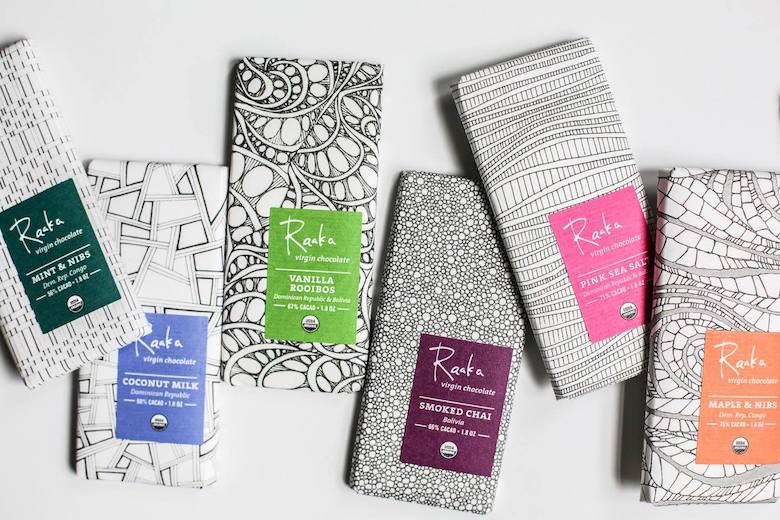
Sometimes it takes time to create something special. In the case of new book The Art and Craft of Chocolate, which charts the origins of chocolate and its wide-ranging cultural influence through to today’s cacao-based creations, it took over a year and several weeks’ worth of air travel.
Authored by Red Hook–headquartered Raaka craft chocolate co-founder and budding culinary historian Nathan Hodge, the 160-page book was conceived as a “digestible” introduction to “the journey of chocolate from tree to bar.” Featuring an inspiring foreword from selmelier and longtime chocolate aficionado Mark Bitterman (an “inspiration,” says Hodge) The Art and Craft of Chocolate invites readers to take a deeper and more “cuisine-focused” look at a ubiquitous product in the hopes they fall in love with it, too.
Split into two sections, Hodge’s book details the history of chocolate followed by a range of recipes. Combined, both parts showcase chocolate’s many guises over the ages, from botanical to cultural treasure, including lesser-known creations that didn’t stand the test of time. Conceived as “a different approach to chocolate that takes it outside the candy aisle,” the book is designed to be a helpful reference for schools and libraries as much as chocolate lovers.
The book also features delicious imagery from photographer Mike Grippi and some sourced from a Oaxaca-based women’s union. Hodge admits the latter set of images was the hardest part of the book to secure of all, “They view [chocolate cuisine] as something that should be revered and not replicated,” referring to difficulties gaining access to recipes and images of production. However the chocolatier is also understanding of this guardedness given the rich cultural heritage, “from Mayan to Zapotec to Oaxacan,” those women are fighting to preserve.
As a result, many of the recipes in the book, such as “Cocoa Kahlúa” and “Chocolate Tortillas,” serve as guidelines to encourage experimentation. Similarly, many recipes draw from others, including the “Simple Chocolate Sauce” that forms the basis of many sweet and savory recipes.
Hodge, an explorer by inclination as much as trade, enjoyed the process of collaborating with colleagues at Raaka and fellow food friends, including Gotham Greens, to work on the recipes. He also brings his extensive knowledge of botany, cacao culture and a passion for helping people “expand the way they think about chocolate” to fruition through a detailed but approachable journey.

Black sesame and cocoa nib toffee
Makes about 16 pieces
2 cups (455 g) butter (non-dairy alternatives: min. 75% vegetable oil content)
2 cups (455 g) sugar
¼ cup (60 ml) water
¾ teaspoon salt
1½ tablespoons (6 g) cocoa nibs
1 teaspoon black sesame seeds
10 ounces (280g) chocolate, tempered
Combine the butter, sugar, water and salt in a 1½- to 2-quart (1.1 to 1.9 L) saucepan (preferably copper). The size of the pan is really important here. The mixture needs room to bubble up, but not so much that it cooks too quickly and burns in spots.
Cook over medium-high heat while stirring constantly with a wooden spoon until the mixture reaches 300°F (150°C), the hard crack stage. When you reach this temperature, your mixture should be a bubbly, dancing substance with an opaque golden-brown color. If you get into the mid-200° and your substance is showing signs of separation, see troubleshooting tip below.
Once you reach the proper temperature, remove the pot from the heat and continue to stir. While stirring, add the sesame seeds and cocoa nibs. Once they’re mixed in, immediately dump the mixture onto an ungreased baking sheet and spread it around by tilting the pan back and forth. Speed is pretty important here, so make sure you have everything laid out and ready to go. Set aside and allow the toffee to cool.
Put half of the tempered chocolate in a double boiler over medium heat, stir, and allow to fully melt. Turn off the heat, and stir in the other half of the chocolate until fully melted.
Place a piece of parchment or waxed paper on a baking sheet. Break the toffee into whatever size pieces you desire and dip them in the chocolate, coating about half of each piece. Place the toffee on the lined baking sheet to set. Sprinkle additional nibs and/or sesame seeds over the top of the chocolate-coated toffee.
Troubleshooting note:
If your mixture separates somewhere between 230°F and 260°F (110°C and 127°C) or has not bonded together, take the pot off the heat and add about a tablespoon of water. Stir and allow to cool to 200°F (93°C). Put the pot back on the heat and heat to 300°F (150°C). The additional water should help stabilize your mixture.






